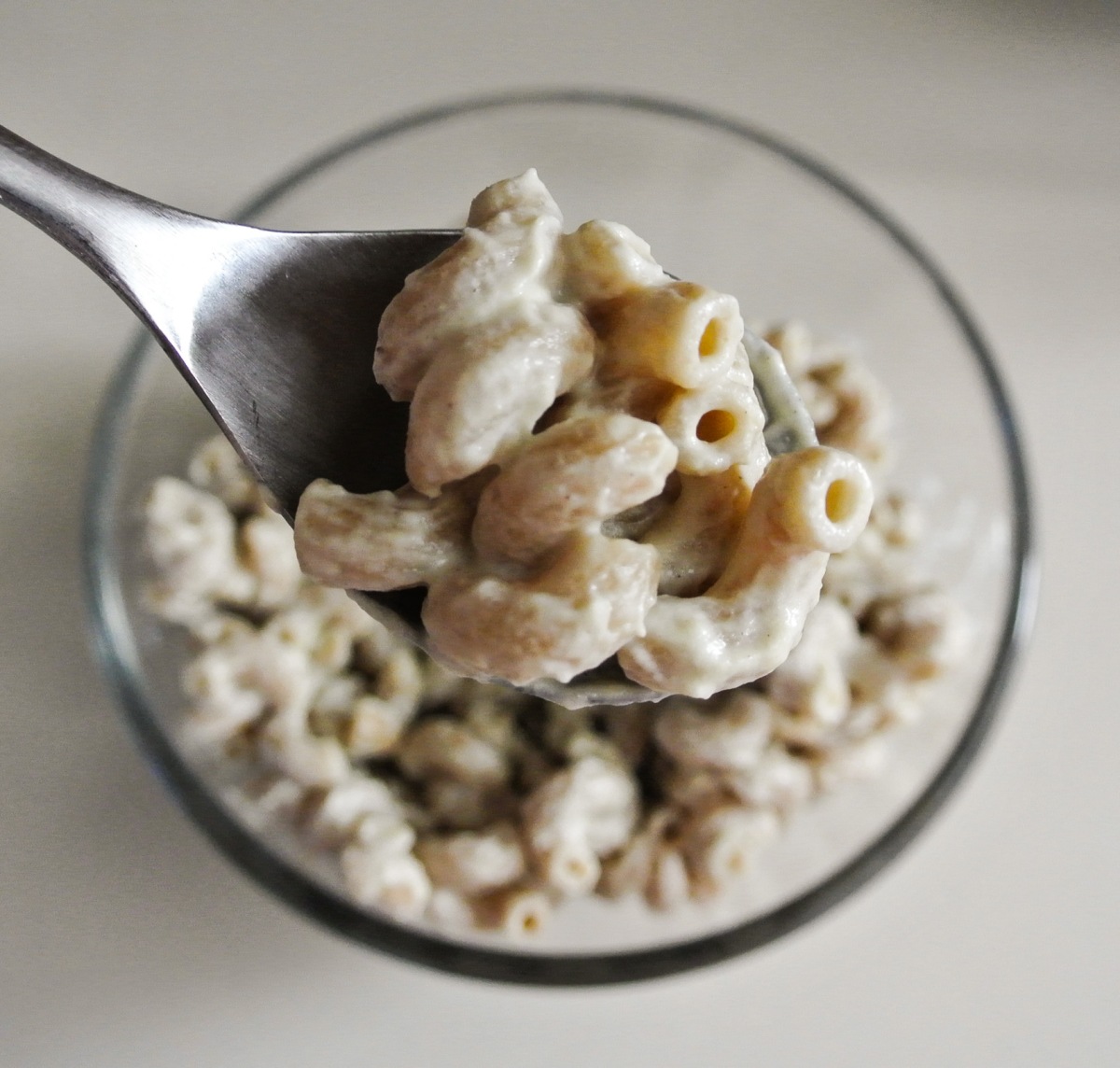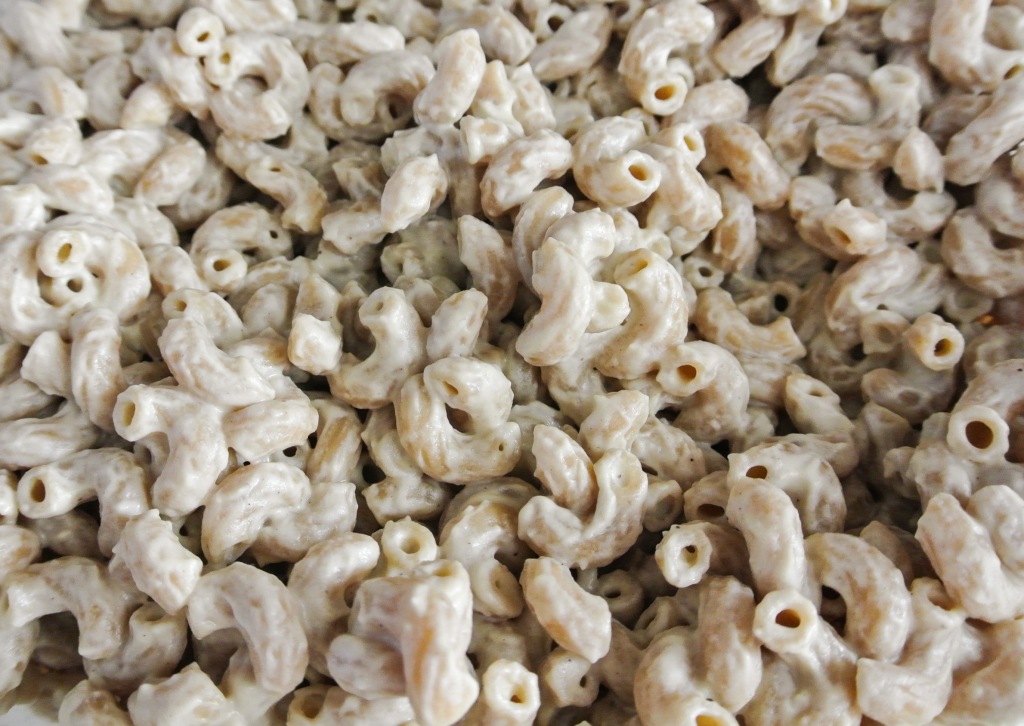Oh, eggplant. I’m sure I’m not alone in stating that it isn’t my favorite vegetable. Up until recently, I’ve only been able to think of a handful of ways to make it truly delicious and appetizing. One of those methods includes breading and frying it in classic eggplant parmesan. Totally scrumptious, yes, but this popular Italian vegetarian dish contains so many unhealthy components that the benefits of the eggplant practically become negated.
When Nolan was just beyond eating only pureed fruits and veggies and on to soft whole foods, I thought that eggplant would make for a unique sauce. Since I was so used to pureeing it for him anyway, I imagined that flavoring it up and pouring it over pasta would make it more appetizing for me, too.
I’m happy to report that that early kitchen experiment was a success. When I had leftover cashew cream from last week’s potato salad, I got creative in taking my original eggplant pasta sauce up a notch. The addition of the cashew cream provided for a dairy-like richness that reminds me of an alfredo, sans all of those animal products.
If you, too, are struggling to make the best of the mysterious purple vegetable that, in fact, is nothing like an egg at all, today, you are in luck! While an appealing flavor and texture transformation might be reason enough to make this pasta sauce, the eggplant contains a whole host of health benefits. First, it contains cholorogenic acid, known to prevent healthy cells from mutating into cancer cells and also a key player in lowering bad cholesterol. Secondly, it is low calories, but high in fiber, vitamins, and minerals. Its blandness—like the russet potato—is an ideal blank slate for something like a pasta sauce.
 In other news, you’ll see that this formula calls for some type of acid. I have found that just a touch of something acidic really brightens the sauce, resulting in a creamy pasta experience that won’t leave you feeling heavy and bloated. Today, I’m using white balsamic vinegar; white, simply to maintain that alfredo-like, off-white color. Check out my multi-grain salad formula for more info on the health benefits of vinegar and this brand, which is my go-to:
In other news, you’ll see that this formula calls for some type of acid. I have found that just a touch of something acidic really brightens the sauce, resulting in a creamy pasta experience that won’t leave you feeling heavy and bloated. Today, I’m using white balsamic vinegar; white, simply to maintain that alfredo-like, off-white color. Check out my multi-grain salad formula for more info on the health benefits of vinegar and this brand, which is my go-to:
 Truthfully, this formula is in its newborn stages and I’m not sure how it would hold up to substituting different vegetables, but I imagine that it’s the cashew cream that brings it together. Point is, if you pureed nearly any cooked vegetable with the cashew cream, I think that you would achieve a similar sauce (in consistency, at least). Try this out with eggplant first and see how it goes with another of your favorites that you have been fruitless in repurposing. Enjoy!
Truthfully, this formula is in its newborn stages and I’m not sure how it would hold up to substituting different vegetables, but I imagine that it’s the cashew cream that brings it together. Point is, if you pureed nearly any cooked vegetable with the cashew cream, I think that you would achieve a similar sauce (in consistency, at least). Try this out with eggplant first and see how it goes with another of your favorites that you have been fruitless in repurposing. Enjoy!
FORMULA BASE: VEGETABLE PASTA SAUCE
Yields sauce for one box of pasta
- 2 cups coarsely chopped raw vegetables –> I’m using eggplant.
- ½ cup cashew cream (soak raw cashews overnight, drain, and blend with just enough water to form a thick cream)
- 2 tbsps nutritional yeast
- 1 tbsp acid (i.e. vinegar, mustard, citrus juice, etc.) –> I’m using white balsamic vinegar.
- ¼-1 tsp seasoning (i.e. fresh/dried herbs, spices, etc.) –> I’m using ¼ tsp ground nutmeg.
- Pink Himalayan sea salt and fresh ground pepper to taste –> I’m using approximately ½ tsp salt and several turns of pepper.
Peel (if necessary) and chop your vegetables. Steam, roast, or boil (I’m steaming) to cook. The Baby Bullet Steamer: not just for baby food! 🙂
 While your vegetables are cooking, bring a pot of water to a boil and prepare your pasta of choice. When the vegetables are finished, combine with all other ingredients (except the pasta, of course!) in a blender and puree until smooth and creamy.
While your vegetables are cooking, bring a pot of water to a boil and prepare your pasta of choice. When the vegetables are finished, combine with all other ingredients (except the pasta, of course!) in a blender and puree until smooth and creamy.
Pour atop your pasta (or use in another application) and enjoy immediately for most desirable consistency. It will keep just fine in the fridge, but will dry out a bit.



[…] cashews. I’ve been using cashews in everything lately, from my “alfredo” sauce to my creamy vegetable sauce to this cake topper. It’s amazing how smoothly they blend up and I’ve come to prefer […]
LikeLike
[…] introduced my creamy vegetable pasta sauce to you with the loved and loathed eggplant. At the time, I hadn’t tried the formula with another […]
LikeLike
[…] have concocted a number of formulas for vegan alternatives that are just as satisfying as dairy: creamy pasta sauce, mousse, frosting, whipped cream, etc. I have never, however, claimed that they are the same; vegan […]
LikeLike
[…] Sometimes, I’ve just gotta have a big, warm bowl of old school pasta drowning in my marinara or cream sauce. Lately, however, I’ve been making an effort to get back into working out and toning my post-baby […]
LikeLike
[…] I first developed my creamy vegetable sauce formula, I had only tried it out with eggplant and wasn’t sure it how it would work with other veggies. […]
LikeLike